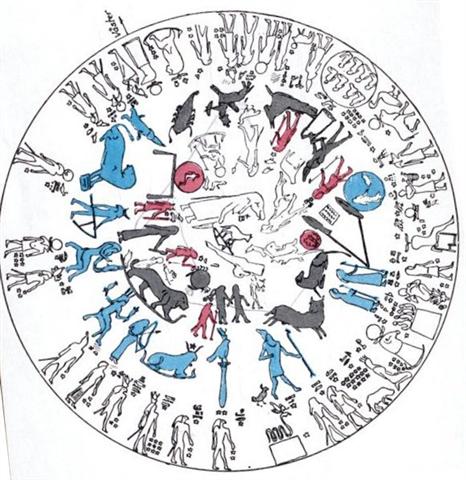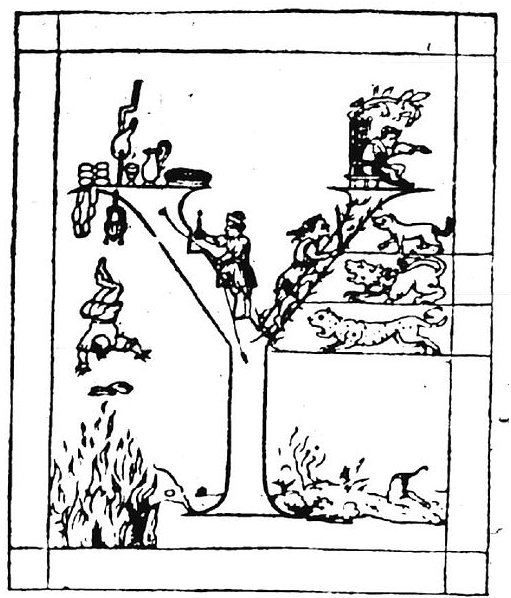Kjellson tells us that the difference between his grey-marked (= our own wellknown) zodiac and the foreign blue-marked zodical constellations could be due to a shift in coordinates with 21°:  ... In the Dendera round zodiac Kjellson (Henry Kjellson, Forntidens teknik) carefully measured the distance from our own well known 12 zodiacal figures (painted grey in his illustration) to a sequence of 11 unfamiliar bluemarked ones and found the result to be 21º as regards the position of the north pole. However, 21º is outside the range of the obliquity:
Therefore the blue figures were probably arranged 'in timespace and not in spacetime'. We can guess 21º represented 21 right ascension days, or rather - because zeroes were insignificant - 210 such days ...
... Upsilon is known as Pythagoras' letter, or the Samian letter, because Pythagoras used it as an emblem of the path of virtue or vice. As the Roman writer Persius wrote in Satire III: ... and the letter which spreads out into Pythagorean branches has pointed out to you the steep path which rises on the right. Lactantius, an early Christian author (ca. 240 - ca. 320), refers to this: For they say that the course of human life resembles the letter Y, because every one of men, when he has reached the threshold of early youth, and has arrived at the place 'where the way divides itself into two parts', is in doubt, and hesitates, and does not know to which side he should rather turn himself´... During the northern winter, when the brilliant Orion was clearly visible up in the night sky, it could be observed how he was slowly moving along the ecliptic - he apparently 'walked' on the plain of the planets. The blue shepherd in Kjellson's drawing corresponds to Orion (= Osiris), and who apparently was moving towards his encounter with the Taurus bull in the east - i.e. moving withershins and obeying the Moon instead of the Sun. After the Sun in the evenings had gone down at the horizon in the west he would return by moving back on the other side of the night sky in order to arrive at the horizon in the east. Therefore he had to move in the opposite direction as compared to his daytime movement from the horizon in the east to the horizon in the west. It could be said that from the horizon in the west one of the pair of hulls of his 'double-canoe' went withershins in the night while the other one became the Moon (rising at the horizon in the west and descending in the east). ... On the fifteenth day of the month of October (tangaroa uri), Nonoma left the house [he ea mai roto i te hare] during the night [i te po] to urinate outdoors [ki kaho.mimi]. At this point Ira called out [he rangi] to Nonoma, 'Look at the canoe!' Nonoma ran [he tahuti], he quickly went to Te Hiringa Heru (a ravine in the side of the crater Rano Kau) and looked around. There he saw the double canoe way out near the (offshore) islets [i te motu o haho], and the two (hulls of the canoe) were lashed together ... [E:75] ... He waved, waved, waved [?], and waved. The one on board the boat saw [he tikea e runga e te miro] Raparenga's waving [te rapunga.o Raparenga] and understood. The signals arrived [he angiangi] on board the canoe [he iri mai te rapu o runga i te miro]; the waving arrived below [he topa ki raro.te rapu] (i.e.. in the west). [(Here they) died out, he oti.] The two hulls were no longer kept lashed together (i.e., they were separated for the rest of the journey) ... [E:77] ... The old man gave the Raven two small sticks, like gambling sticks, one black, one multicoloured. He gave him instructions to bite them apart in a certain way and told him to spit the pieces at one another on the surface of the sea. The Raven climbed back up the pole, where he promptly did things backwards, just to see if something interesting would occur, and the pieces bounced apart. It may well be some bits were lost. But when he gathered what he could and tried again - and this time followed the instructions he had been given - the pieces stuck and rumpled and grew to become the mainland and Haida Gwaii ... 16 * 29½ - 5 * 73 = 472 (Moon) - 365 (Sun) = 1½ * 314 - 4 * 91 = 107 |


